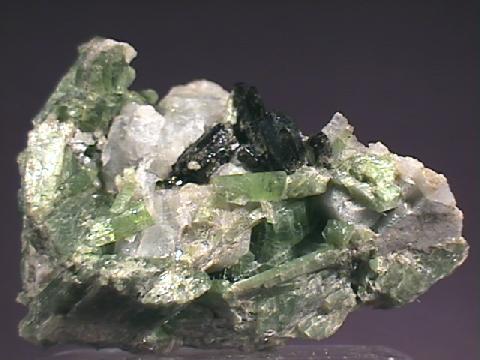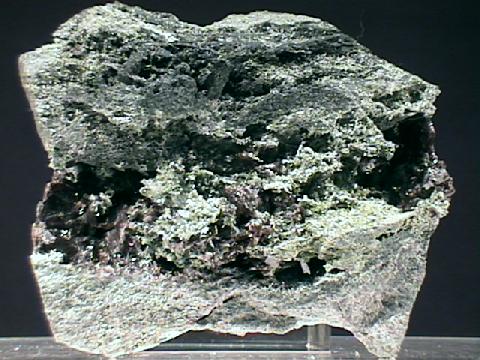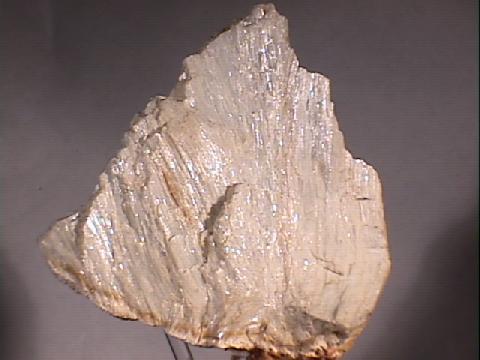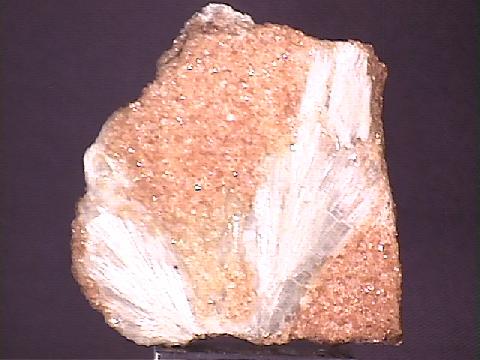 THE MINERAL TREMOLITE
THE MINERAL TREMOLITE
- Chemistry: Ca2Mg5Si8O22(OH)2 , Calcium Magnesium Silicate Hydroxide.
- Class: Silicates
- Subclass: Inosilicates
- Group: Amphibole
- Uses: Asbestos and as a mineral specimen.
Specimens
5CaMg(CO3)2 + 8SiO2 + H2O ------> Ca2Mg5Si8O22(OH)2 + 3CaCO3 + 7CO2
It belongs to a series with the minerals actinolite and
Without the iron in the formula tremolite will have the typical creamy white color. With just a small amount of iron tremolite will be green. Increasing iron content will raise the specific gravity, index of refraction and darken the color.
A variety of tremolite is composed of microscopically fibrous crystals called asbestos. Other minerals also form asbestos such as serpentine and the other minerals of the series mentioned above. Serpentine asbestos is more widely used and of a better grade in general. Although asbestos has been shown to cause cancer in humans when inhaled in high enough concentrations, it still has many valuable applications. Asbestos is used for fire retardant materials and brake shoes and pads. Its prior use as insulation has been all but eliminated due to health concerns.
A variety of actinolite, nephrite, is one of the two minerals called jade. The other jade mineral is jadeite. Although nephrite is considered to be actinolite, the lighter shades of nephrite probably contain significant amounts of tremolite.
Another variety of tremolite is called "mountain leather" or "mountain cork" and is an oddity in the mineral world. The tremolite fibers form a felted mass that has all the appearances and feel of a piece of cloth. The mountain leather will even have attached calcite crystals that seem to be knitted in to the fabric. A violet variety of tremolite is called "hexagonite" and makes for a nice collection specimen with its attractive color and crystalline habit.
Tremolite is an important temperature indicator for petrologists. Because at high temperatures tremolite is unstable and will convert to diopside, CaMgSi2O6. The presence of only tremolite and no diopside indicates that the rock has not endured terribly high temperatures.
Tremolite can be a fun and very interesting mineral to collect.
PHYSICAL CHARACTERISTICS:
- Color is usually white or gray but can be greenish, colorless, yellow and violet.
- Luster is vitreous or silky to dull.
- Transparency: Specimens are translucent to transparent.
- Crystal System is monoclinic; 2/m
- Crystal Habits include flattened prismatic and elongated crystals with a dome-like termination that is actually two of the four faces of a prism. Fibrous crystals form radial aggregates, masses and hair like clusters. Also as a felted mass (asbestos and "mountain leather").
- Cleavage: is perfect in two directions at close to 60- and 120-degree angles (diamond-shaped).
- Fracture is uneven.
- Hardness is 5 - 6.
- Specific Gravity is approximately 2.9 - 3.1 (very slightly above average for translucent minerals).
- Streak is white.
- Other Characteristics: Index of refraction is 1.60 - 1.63.
- Associated Minerals are calcite, grossular, talc and serpentine.
- Notable Occurrences include the area around Wilberforce, Ontario, Canada; De Kalb, St Lawrence Co., New York, California, Arizona and Canaan, Connecticut, USA; Tyrol and Piemonte, Italy; Tremola Valley, Switzerland (hence the name); Tanzania and Finland.
- Best Field Indicators are fibrosity (asbestos), color, cleavage, crystal habit and hardness.













